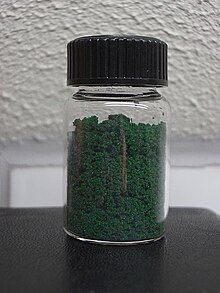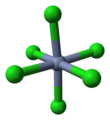Chromium(III) chloride
 Anhydrous
| |
 Dihydrate
| |
| Names | |
|---|---|
| IUPAC names
Chromium(III) chloride
Chromium trichloride | |
| Other names
Chromic chloride
| |
| Identifiers | |
3D model (JSmol)
|
|
| ChEBI | |
| ChEMBL | |
| ChemSpider | |
| ECHA InfoCard | 100.030.023 |
PubChem CID
|
|
| RTECS number |
|
| UNII | |
CompTox Dashboard (EPA)
|
|
| |
| |
| Properties | |
| CrCl3 | |
| Molar mass | 158.36 g/mol (anhydrous) 266.48 g/mol (hexahydrate) |
| Appearance | purple when anhydrous, dark green when hexahydrate |
| Density | 2.87 g/cm3 (anhydrous) 1.760 g/cm3 (hexahydrate) |
| Melting point | 1152 °C (anhydrous) 83 °C (hexahydrate) |
| Boiling point | 1300 °C decomp. |
| slightly soluble (anhydrous) 585 g/L (hexahydrate) | |
| Solubility | soluble in ethanol insoluble in ether, acetone |
| Acidity (pKa) | 2.4 (0.2M solution) |
| Structure | |
| YCl3 structure | |
| Octahedral | |
| Hazards | |
| NFPA 704 (fire diamond) | |
| Flash point | Non-flammable |
| Lethal dose or concentration (LD, LC): | |
LD50 (median dose)
|
440 mg/kg |
| Related compounds | |
Other anions
|
Chromium(III) fluoride Chromium(III) bromide Chromium(III) iodide |
Other cations
|
Molybdenum(III) chloride Tungsten(III) chloride |
Except where otherwise noted, data are given for materials in their standard state (at 25 °C [77 °F], 100 kPa).
| |
Chromium(III) chloride (also called chromic chloride) is a violet coloured solid with the formula CrCl3. The most common form of CrCl3 sold commercially is a dark green hexahydrate with the formula [CrCl2(H2O)4]Cl.2H2O. Two other hydrates are known, pale green [CrCl(H2O)5]Cl2.H2O and violet [Cr(H2O)6]Cl3. This unusual feature of chromium(III) chlorides, having a series of [CrCl3−n(H2O)n]z+, each of which is isolable, is also found with other chromium(III) compounds.
Structure
Anhydrous chromium(III) chloride adopts the YCl3 structure, with Cr3+ occupying two thirds of the octahedral interstices in every other layer of a pseudo-cubic close packed lattice of Cl− ions. The absence of cations in alternate layers leads to weak bonding between adjacent layers. For this reason, crystals of CrCl3 cleave easily along the planes between layers, which results in the flaky appearance of samples of chromium(III) chloride.[1]
-
Space-filling model of cubic close packing of chloride ions in the crystal structure of CrCl3
-
Ball-and-stick model of part of a layer
-
Stacking of layers
-
octahedral coordination of Cr
Preparation
Commercially anhydrous chromium(III) chloride may be prepared by chlorination of chromium metal directly, or indirectly by chlorination of chromium(III) oxide in the presence of carbon at 800 °C, with carbon monoxide as a side-product:[2]
- Cr2O3 + 3 C + 3 Cl2 → 2 CrCl3 + 3 CO
It may also be prepared by treating the hexahydrate with thionyl chloride.
In laboratory it's usually prepared by dissolving the elemental chromium or chromium(III) oxide in hydrochloric acid.
However, it is also a chloro complex which is quite inert to substitution, so in fact it is ordinarily quite unreactive. Slow reaction rates are common with chromium(III) complexes in general. The low reactivity of the d3 Cr3+ ion can be explained using crystal field theory. One way of opening CrCl3 up to substitution in solution is to reduce even a trace amount to CrCl2, for example using zinc in hydrochloric acid. This chromium(II) compound undergoes substitution easily, and it can exchange electrons with CrCl3 via a chloride bridge, allowing all of the CrCl3 to react quickly.
Reactions and uses
CrCl3 is a Lewis acid, classified as "hard" according to the Hard-Soft Acid-Base theory. It forms a variety of adducts of the type [CrCl3L3]z, where L is a Lewis base. For example, it reacts with pyridine (C
5H
5N) to form an adduct:
- CrCl3 + 3 C5H5N → CrCl3(C5H5N)3
Like most chromium(III) compounds, CrCl3 is chemically inert but its neighboring redox state chromium(II) is reactive. Thus, CrCl3 and its complexes generally react only sluggishly in the absence of a reducing agent capable of reducing Cr3+ to Cr2+. With the presence of some chromium(II), however, solid CrCl3 dissolves rapidly in water. Similarly, ligand substitution reactions of solutions of [CrCl2(H2O)4]+ are accelerated by chromium(II) catalysts.
With molten alkali metal chlorides such as potassium chloride, CrCl3 gives octahedral complexes of the type K3CrCl6, as well as K3Cr2Cl9, which is also octahedral but where the two chromiums are linked via three chloride bridges. Chromium(III) chloride is used as the precursor to many inorganic compounds of chromium, for example dibenzenechromium(0), an analogue of ferrocene:
One use of CrCl3 in organic synthesis is for the in situ preparation of chromium(II) chloride, a popular reagent for (A) reduction of alkyl halides and for (B) the synthesis of (E)-alkenyl halides. The reaction is usually performed using two moles of CrCl3 per mole of lithium aluminium hydride, although if aqueous acidic conditions are appropriate zinc and hydrochloric acid may be sufficient.
Chromium(III) chloride has also been used as a Louis acid in organic reactions, for example to catalyse the nitroso Diels-Alder reaction.[3]
Precautions
Although trivalent chromium is far less poisonous than hexavalent, chromium salts are generally considered toxic.
References
- ^ Greenwood, Norman N.; Earnshaw, Alan (1997). Chemistry of the Elements (2nd ed.). Butterworth-Heinemann. p. 1020. ISBN 978-0-08-037941-8.
- ^ D. Nicholls, Complexes and First-Row Transition Elements, Macmillan Press, London, 1973.
- ^ Calvet, G.; Dussaussois, M.; Blanchard, N.; Kouklovsky, C. (2004). "Lewis Acid-Promoted Hetero Diels-Alder Cycloaddition of α-Acetoxynitroso Dienophiles". Organic Letters. 6 (14): 2449–2451. doi:10.1021/ol0491336. PMID 15228301.
{{cite journal}}: CS1 maint: multiple names: authors list (link)
Further reading
- N. N. Greenwood, A. Earnshaw, Chemistry of the Elements, 2nd ed., Butterworth-Heinemann, Oxford, UK, 1997.
- Handbook of Chemistry and Physics, 71st edition, CRC Press, Ann Arbor, Michigan, 1990.
- The Merck Index, 7th edition, Merck & Co, Rahway, New Jersey, USA, 1960.
- A. F. Wells, 'Structural Inorganic Chemistry, 5th ed., Oxford University Press, Oxford, UK, 1984.
- J. March, Advanced Organic Chemistry, 4th ed., p. 723, Wiley, New York, 1992.
- K. Takai, in Handbook of Reagents for Organic Synthesis, Volume 1: Reagents, Auxiliaries and Catalysts for C-C Bond Formation, (R. M. Coates, S. E. Denmark, eds.), pp. 206–211, Wiley, New York, 1999.







